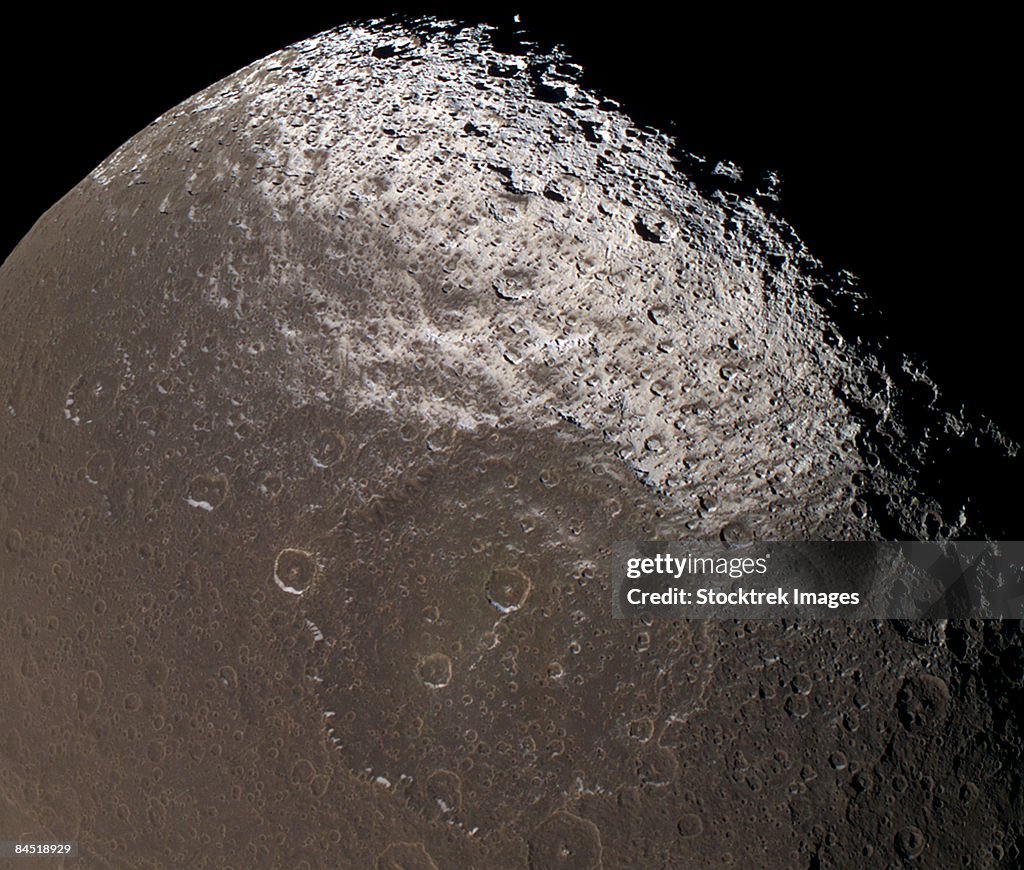Saturn's moon Iapetus. - Foto stock
December 31, 2004 - Dark-stained Iapetus. This near-true color view from Cassini reveals the colorful and intriguing surface of Saturn's moon Iapetus in unrivaled clarity. The use of color on Iapetus is particularly helpful for discriminating between shadows (which appear black) and the intrinsically dark terrain (which appears brownish). This image shows the northern part of the dark Cassini Regio and the transition zone to a brighter surface at high northern latitudes. Within the transition zone, the surface is stained by roughly north-south trending wispy streaks of dark material. The absence of an atmosphere on Iapetus means that the material was deposited by some means other than precipitation, such as ballistic placement from impacts occurring elsewhere on Iapetus, or was captured from elsewhere in the Saturn system. Iapetus's north pole is not visible here, nor is any part of the bright trailing hemisphere. Images taken with infrared (centered at 930 nanometers), green (568 nanometers), and ultraviolet light (338 nanometers) filters were combined to create this image. The view was obtained with the Cassini spacecraft narrow angle camera on December 31, 2004, at a distance of about 172,900 kilometers (107,435 miles) from Iapetus.

Ottieni questa immagine scegliendo tra varie cornici su Photos.com.
ACQUISTA UNA LICENZA
Tutte le licenze royalty-free comprendono diritti di utilizzo globali, protezione completa e prezzi semplici con sconti sul volume di acquisto
385,00 €
EUR
Getty ImagesSaturns Moon Iapetus, Foto stock Scarica da Getty Images autentiche foto stock premium di Saturn's moon Iapetus.. Esplora foto stock simili ad alta risoluzione nel nostro vasto catalogo.Product #:84518929
Scarica da Getty Images autentiche foto stock premium di Saturn's moon Iapetus.. Esplora foto stock simili ad alta risoluzione nel nostro vasto catalogo.Product #:84518929
 Scarica da Getty Images autentiche foto stock premium di Saturn's moon Iapetus.. Esplora foto stock simili ad alta risoluzione nel nostro vasto catalogo.Product #:84518929
Scarica da Getty Images autentiche foto stock premium di Saturn's moon Iapetus.. Esplora foto stock simili ad alta risoluzione nel nostro vasto catalogo.Product #:84518929385€50€
Getty Images
In stockDETTAGLI
Attestazione:
N. Creative:
84518929
Tipo di licenza:
Collezione:
Stocktrek Images
Max. dimensione file:
3424 x 2910 px (28,99 x 24,64 cm) - 300 dpi - 5 MB
Data di upload:
Info sulla liberatoria:
Liberatoria non necessaria
Categorie: